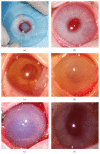Extraction of Iron from the Rabbit Anterior Chamber with Reverse Iontophoresis
- PMID: 26257921
- PMCID: PMC4518192
- DOI: 10.1155/2015/425438
Extraction of Iron from the Rabbit Anterior Chamber with Reverse Iontophoresis
Abstract
Ocular siderosis is a common eye disease caused by retention of an iron-containing intraocular foreign body in the eye. Iron-containing intraocular foreign bodies may cause severe inflammatory reaction and affect visual function. Currently the optimal treatment method of ocular siderosis is a moot point. This study used the reverse iontophoresis technique to noninvasively extract iron from the rabbit anterior chamber. By slit lamp observation and histological examination, reverse iontophoresis treatment has a good effect on ocular siderosis. Reverse iontophoresis seems to be a noninvasive and promising approach to extract iron from the anterior chamber to treat ocular siderosis.
Figures




References
-
- Xie H., Chen S. Ocular siderosis. Eye science. 2013;28(2):108–112. - PubMed
-
- Duke-Elder S., MacFaul P. A. Injuries: I. Mechanical injuries. In: Duke-Elder S., editor. Systems of Ophthalmology. St. Louis, Mo, USA: Mosby; 1972. pp. 525–544.
LinkOut - more resources
Full Text Sources
Other Literature Sources

